Tim Smith
 Artist: Tim Smith
Artist: Tim Smith
Genre: Projection Mapping
His Art:
Tim Smith is a projection artist. A mesmerizing marriage of public art and technology, projection mapping involves projecting videos onto unconventional surfaces such as buildings, interior spaces, natural landscapes, and sculptures. It is a compelling way of telling stories and bringing 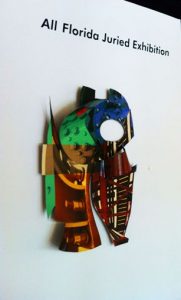 vibrant visual effects into dark environments and nighttime settings. This projection technique offers productive new approaches to storytelling, community building, and even urban planning with cultural exchange at its roots.
vibrant visual effects into dark environments and nighttime settings. This projection technique offers productive new approaches to storytelling, community building, and even urban planning with cultural exchange at its roots.
Tim was introduced to projection mapping in 2008.
“I thought to myself, I have to learn how to do this,” Tim relates.
He received a Surdna grant for artists who were educators and used it to attend a two-week arts and technology workshop at the Art Institute of Chicago.
“While I was in Chicago, we went as a group to the Museum of Contemporary Art. 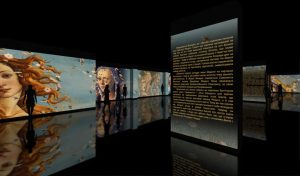 They were hosting a digital art show. That show opened my mind to so many new possibilities that I could incorporate into my Kinetic wafers.”
They were hosting a digital art show. That show opened my mind to so many new possibilities that I could incorporate into my Kinetic wafers.”
Eager to try out his new skill set, Tim decided to use the back of the Dean Hotel at the corner of Dean and Bay streets as 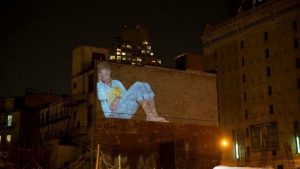 a blank canvas during an Art Walk in 2010. In the best tradition of guerrilla art, he got a ladder and carried his equipment on top of the Hideaway Bar.
a blank canvas during an Art Walk in 2010. In the best tradition of guerrilla art, he got a ladder and carried his equipment on top of the Hideaway Bar.
“I had a wall to project on that was 40 feet by 40 feet painted white,” recounts Tim, who confesses to being nervous 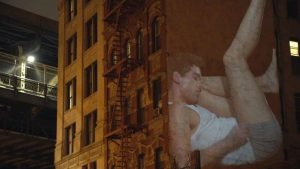 about getting arrested and thrown in jail. But he tamped down his anxiety, pulled the electrical current he needed from a nearby streetlight and fired up his large-scale projector.
about getting arrested and thrown in jail. But he tamped down his anxiety, pulled the electrical current he needed from a nearby streetlight and fired up his large-scale projector.
“When it started getting dark I could see I was able to project on 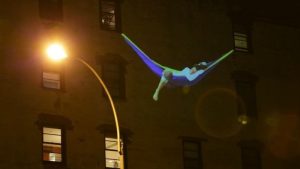 the whole surface,” Tim continues. “I climbed down and let it play. I sat at an outside table at Fords Garage and watched as people walked by and saw it for the first time. I loved their reactions. Many stopped and got out their phones and took video of my Kinetic Wafers making their first appearance to the public.”
the whole surface,” Tim continues. “I climbed down and let it play. I sat at an outside table at Fords Garage and watched as people walked by and saw it for the first time. I loved their reactions. Many stopped and got out their phones and took video of my Kinetic Wafers making their first appearance to the public.”
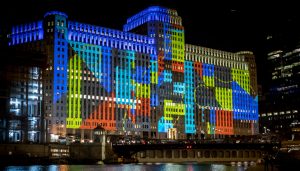 Since then, Tim has created and projected many works on the buildings located in downtown Fort Myers, receiving several Arts and Culture grants from the City of Fort in support of his work. The last grant he received is helping finance his “City as Gallery” project, which seeks to turn downtown Fort Myers into an open-air gallery in which spectators can
Since then, Tim has created and projected many works on the buildings located in downtown Fort Myers, receiving several Arts and Culture grants from the City of Fort in support of his work. The last grant he received is helping finance his “City as Gallery” project, which seeks to turn downtown Fort Myers into an open-air gallery in which spectators can 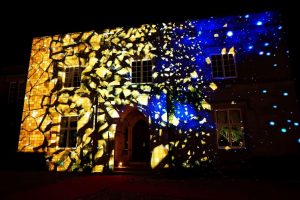 view the whole collection in a single evening. He has also been hired by the River District Alliance to project on buildings during Art Walk and Music Walk.
view the whole collection in a single evening. He has also been hired by the River District Alliance to project on buildings during Art Walk and Music Walk.
As a relatively new field of artistic expression, Projection Mapping has gone from an interesting gimmick to gaining more and more traction in the art community at large. 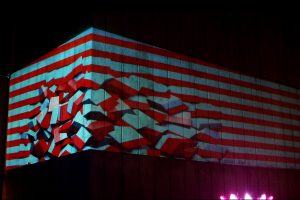 Also known as Video Mapping, Pixel Mapping and Spatial Augmented Reality, Projection Mapping is quickly becoming one of the most vibrant and interesting ways to display a public exhibition. Today, it is recognized as a highly-imaginative, immersive storytelling technique that combines light, color, movement, sound and even interactive components. By mapping moving, projected imagery
Also known as Video Mapping, Pixel Mapping and Spatial Augmented Reality, Projection Mapping is quickly becoming one of the most vibrant and interesting ways to display a public exhibition. Today, it is recognized as a highly-imaginative, immersive storytelling technique that combines light, color, movement, sound and even interactive components. By mapping moving, projected imagery 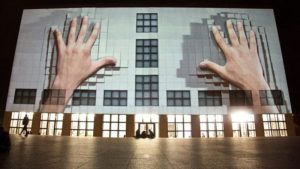 onto buildings, sculptures and even nature itself, artists are able to transform an entire landscape into something wholly alien and original. Or as journalist and art consultant Louis M. Brill puts it, “Whether its canvas is a 13th century castle, an iconic museum, or even a half-kilometer-long string
onto buildings, sculptures and even nature itself, artists are able to transform an entire landscape into something wholly alien and original. Or as journalist and art consultant Louis M. Brill puts it, “Whether its canvas is a 13th century castle, an iconic museum, or even a half-kilometer-long string 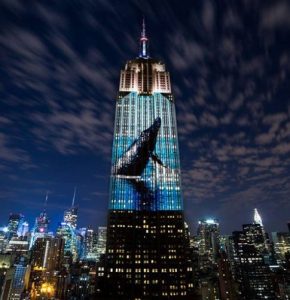 of grain silos, projection mapping has effectively released high-definition video from the rectangular prison of the display screen.”
of grain silos, projection mapping has effectively released high-definition video from the rectangular prison of the display screen.”
Projection Mapping involves four steps. The first involves finding a venue with an interesting projection surface, vis: one that has a façade that contains numerous protrusions, columns, railings and sculptured surfaces. Then the artist will employ a range of software to generate a 3D model of the building or other structure and animation or graphic content that conforms to the 3D model. Once that is completed, the content 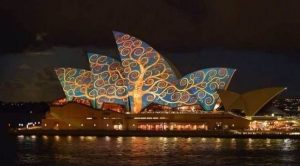 is then projected onto the actual facade or space using high-lumen video projectors, powerful sound systems and media servers.
is then projected onto the actual facade or space using high-lumen video projectors, powerful sound systems and media servers.
“Many large cities such as New York and Chicago have already been using this medium to lead the way in art and 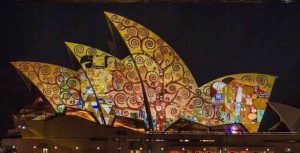 technology,” Tim adds.
technology,” Tim adds.
In fact, a number of artists worldwide have appropriated landmark spaces as digital canvases. For instance, in 2015 the Sidney Opera House enlisted the aid of Universal Everything, a UK-based animation studio, to create a Projection Mapping 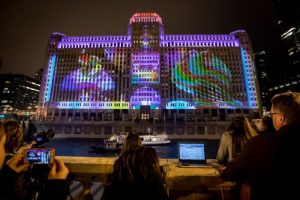 show that utilized 22 different artists, each showcasing 30 seconds of individual animated material. The show was so well received that it’s become an annual event.
show that utilized 22 different artists, each showcasing 30 seconds of individual animated material. The show was so well received that it’s become an annual event.
Other famous displays have included the Romanian Parliament Palace (in a project that combined elements of architecture, physics, chemistry and 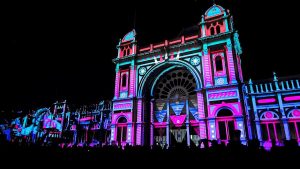 geometry to provide the audience with a unique and gorgeous five-minute display), the Royal Pavilion Garden in Brighton, England (where Projection Mapping was used to tell the tale of how the Brighton Pavilion was used as a military hospital in World War 1), the imposing Senate House in London’s Russell Square
geometry to provide the audience with a unique and gorgeous five-minute display), the Royal Pavilion Garden in Brighton, England (where Projection Mapping was used to tell the tale of how the Brighton Pavilion was used as a military hospital in World War 1), the imposing Senate House in London’s Russell Square 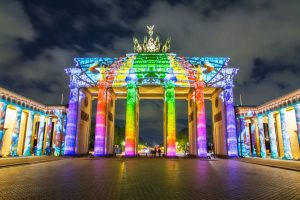 (which was not only frozen, but induced audience members to break off chunks of ice using laser cannons as a virtual climber attempted to scale the 3D ice wall), the Hala Stulecia Museum of Architecture in Wroclaw, Poland (one of the few permanent Projection Mapping installations in the world), the Customs House in Brisbane, Australia (a virtual mine) and, predictably, Universal Studios
(which was not only frozen, but induced audience members to break off chunks of ice using laser cannons as a virtual climber attempted to scale the 3D ice wall), the Hala Stulecia Museum of Architecture in Wroclaw, Poland (one of the few permanent Projection Mapping installations in the world), the Customs House in Brisbane, Australia (a virtual mine) and, predictably, Universal Studios 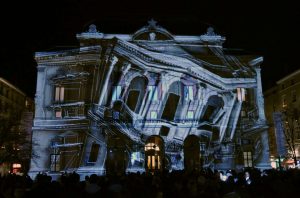 Orlando.
Orlando.
Artists have been utilizing technology to push the boundaries of their art for millennia and it is certainly no different in contemporary times. As an art form, Projection Mapping is still in its embryonic stage, but it gives every indication of growing into a significant force in the world of art. In the  past three years, it has taken off as a means to create jaw-dropping, reality-smashing 3D outdoor spectacle: trompe l’oeil on a gigantic, pulsating scale. The results have created blockbuster enthusiasm from the flash audiences attending these visual spectacles. And when the projection mapping experience goes viral by dint of
past three years, it has taken off as a means to create jaw-dropping, reality-smashing 3D outdoor spectacle: trompe l’oeil on a gigantic, pulsating scale. The results have created blockbuster enthusiasm from the flash audiences attending these visual spectacles. And when the projection mapping experience goes viral by dint of 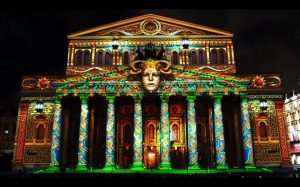 smart phones and professional video documentation, events suddenly become YouTube and Vimeo phenomenon shared by the planet, creating exponential impacts. And the artists creating these displays have begun to reinvent themselves as interactive engagement artists intent on creating “immersive and interactive environments
smart phones and professional video documentation, events suddenly become YouTube and Vimeo phenomenon shared by the planet, creating exponential impacts. And the artists creating these displays have begun to reinvent themselves as interactive engagement artists intent on creating “immersive and interactive environments 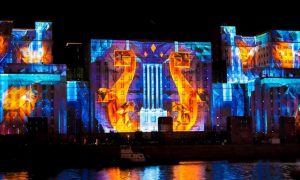 that bring the viewer into the immediacy of the experience,” in the words of Evan Grant, founder of London-based studio Seeper which is at the forefront of Projection Mapping and part of the avante-garde art community that is creating content that is sparking the world’s imagination.
that bring the viewer into the immediacy of the experience,” in the words of Evan Grant, founder of London-based studio Seeper which is at the forefront of Projection Mapping and part of the avante-garde art community that is creating content that is sparking the world’s imagination.
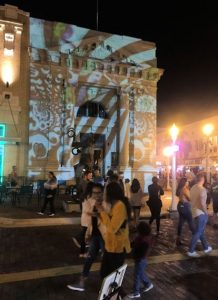 “I have worked many hours to understand the possibilities. I have taken workshops in Chicago for art and technology and spoken to many artists about this concept. I believe these works can bring a meaningful contribution to the arts and culture in the city of Fort Myers as well.
“I have worked many hours to understand the possibilities. I have taken workshops in Chicago for art and technology and spoken to many artists about this concept. I believe these works can bring a meaningful contribution to the arts and culture in the city of Fort Myers as well.
To date, Tim’s favorite projection was on First National Bank building that Walter Langford and William H. Towles erected between 1913 and 1914 on the southeast corner of 1st and Hendry streets. Fittingly, his next Projection Mapping project will utilize the historic Langford Kingston Home, which Walter Langford built in 1919, shortly before his untimely demise on November 15, 1920 at the age of 47.
But with projects such as these to his credit, can the Luminary Hotel be far behind?
Bio
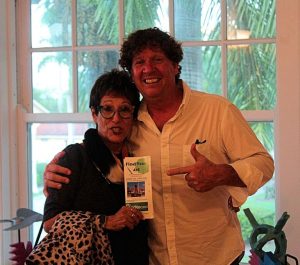 Smith teaches art at Cypress Lake High School Center for the Arts, the premier fine and performing arts school in Lee County.With more than thirty years in the Lee County school system, Tim is a member of the Lee Arts Educator’s Association, The Florida Art Educators Association, The National Art Educators Association and the National Council for Educators in the Ceramic Arts. He is also currently the CEO and founder of Sanibel Pottery Studio School Inc. a nonprofit organization established in 2019.
Smith teaches art at Cypress Lake High School Center for the Arts, the premier fine and performing arts school in Lee County.With more than thirty years in the Lee County school system, Tim is a member of the Lee Arts Educator’s Association, The Florida Art Educators Association, The National Art Educators Association and the National Council for Educators in the Ceramic Arts. He is also currently the CEO and founder of Sanibel Pottery Studio School Inc. a nonprofit organization established in 2019.
October 30, 2021














 Tom Hall is both an amateur artist and aspiring novelist who writes art quest thrillers. He is in the final stages of completing his debut novel titled "Art Detective," a story that fictionalizes the discovery of the fabled billion-dollar Impressionist collection of Parisian art dealer Josse Bernheim-Jeune, thought by many to have perished during World War II when the collection's hiding place, Castle de Rastignac in southern France, was destroyed by the Wehrmacht in reprisal for attacks made by members of the Resistance operating in the area. A former tax attorney, Tom holds a bachelor's degree as well as both a juris doctorate and masters of laws in taxation from the University of Florida. Tom lives in Estero, Florida with his fiancee, Connie, and their four cats.
Tom Hall is both an amateur artist and aspiring novelist who writes art quest thrillers. He is in the final stages of completing his debut novel titled "Art Detective," a story that fictionalizes the discovery of the fabled billion-dollar Impressionist collection of Parisian art dealer Josse Bernheim-Jeune, thought by many to have perished during World War II when the collection's hiding place, Castle de Rastignac in southern France, was destroyed by the Wehrmacht in reprisal for attacks made by members of the Resistance operating in the area. A former tax attorney, Tom holds a bachelor's degree as well as both a juris doctorate and masters of laws in taxation from the University of Florida. Tom lives in Estero, Florida with his fiancee, Connie, and their four cats.